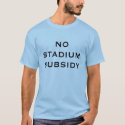There are several ways to look at the word "anchor."
When Santa Clara Councilman Kevin Moore described the proposed San Francisco 49ers' stadium as "one heck of an anchor" in building "an incredible entertainment district," he was probably thinking about an anchor as "a source of security or stability."
When I nicknamed my new sofa bed "the anchor" (many, many years ago), I was thinking of it in terms of something that would weigh me down. No longer would I be able to move all of my possessions in a small car at the drop of a hat.
I'd need movers. And a van.
That sofa bed was a clear limit on my ability to move around—not quite a noose, but a definite restriction.
And the more I think about the dark stadium and the overflowing toilet analogy (not to mention that $250 million plus 15 acres of land), the stadium seems to be that second kind of anchor—the one that weighs you down and restricts your movement.
In part, blowing an enormous wad of cash on a stadium means that there will be little if anything left to build the rest of this entertainment district. And while the San Francisco 49ers have painted rosy pictures of the economic impact a stadium might have, very little (if any) actual cash will flow to the city.
The only way the city will receive any direct cash is if the Stadium Authority profits exceed $1,000,000. While the San Francisco 49ers have certainly projected at least some money going back to the city (and please, read their report for yourself if you want to see their projections), the city would be far better off simply investing the $200 million in a money market account.
Of course, cash parked in a money market account isn't very entertaining.
But is a stadium?
If a stadium was built as the anchor to an entertainment district, this district would be nearly inaccessible to non-attendees on game days. According to the San Francisco 49ers traffic plans (again, please see their report for the full details) traffic on all of the streets surrounding this area would be severely limited on game days. In fact, a portion of Tasman Drive would be completely closed, and other surrounding streets would be closed post-game. (Unless you live in those areas, in which case you'll have to get permission from a police officer to pass into your own neighborhood. Or at least that was what the 49ers said at the April 24, 2007, City Council meeting.)
So on a game day—a lovely Sunday afternoon—who would brave the stadium traffic to visit the entertainment district? And as Au pointed out, the more events that are held at the stadium—remember, more events are the only chance the city has to generate any real cash from this project—the more days this entertainment district is virtually inaccessible to anyone not attending the game or event. And if you're at the game, you aren't also seeing a movie or attending a concert or doing anything else in the rest of this district.
If the City Council thinks that 68,000-seat stadium can be a positive addition to an entertainment district (and a majority of Council members have indicated that they do), then wouldn't it be better to limit our cash investment in this project so that we can build the rest of the district? Let the San Francisco 49ers worry about making the stadium profitable while the city works on ways to develop the district outside the stadium.
Putting $200 million of our eggs in this stadium basket will weigh the city down and limit its ability to respond to other entertainment possibilities.
And that restriction makes a publicly-financed stadium a real anchor.
Wednesday, May 9, 2007
Subscribe to:
Post Comments (Atom)

No comments:
Post a Comment